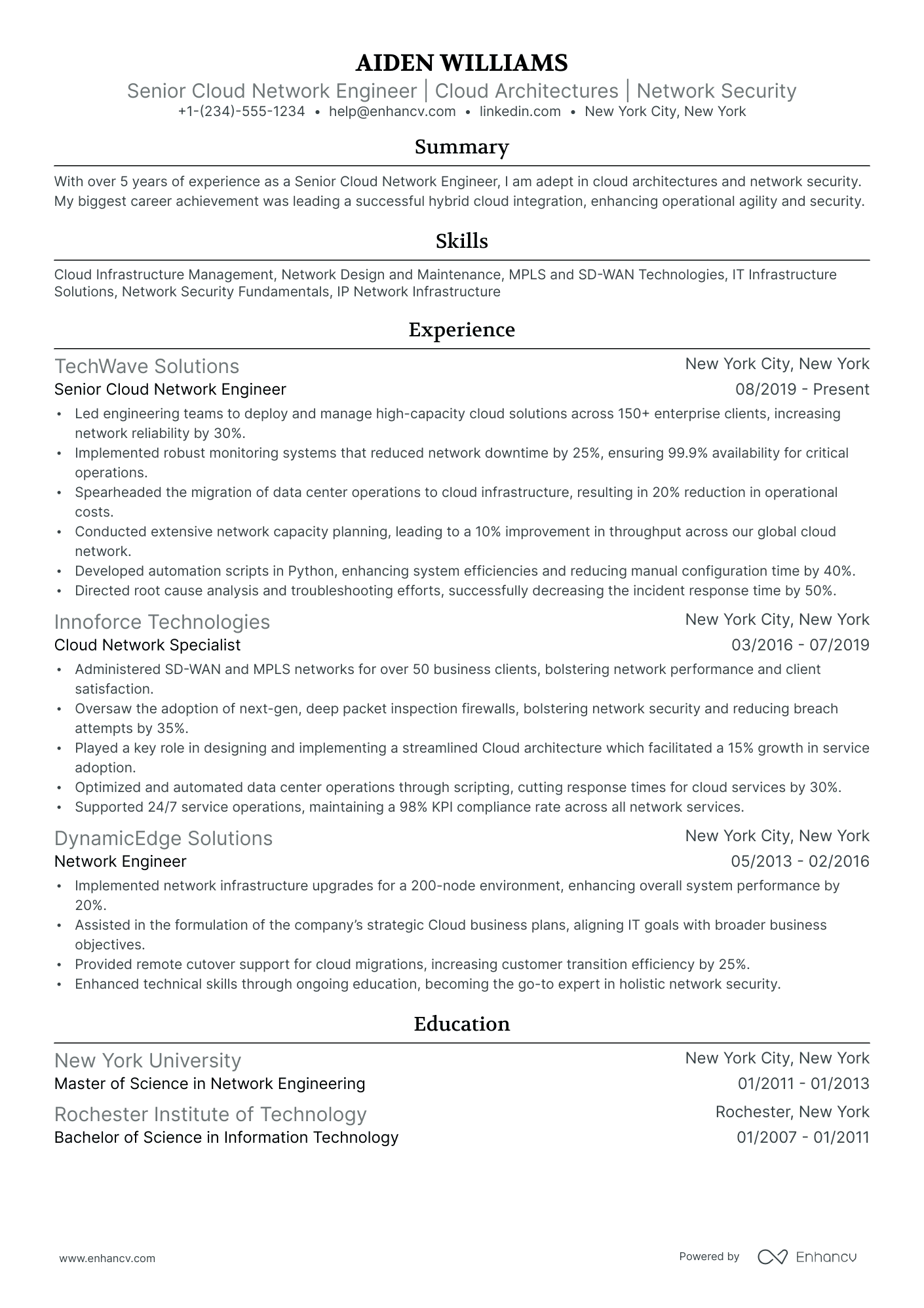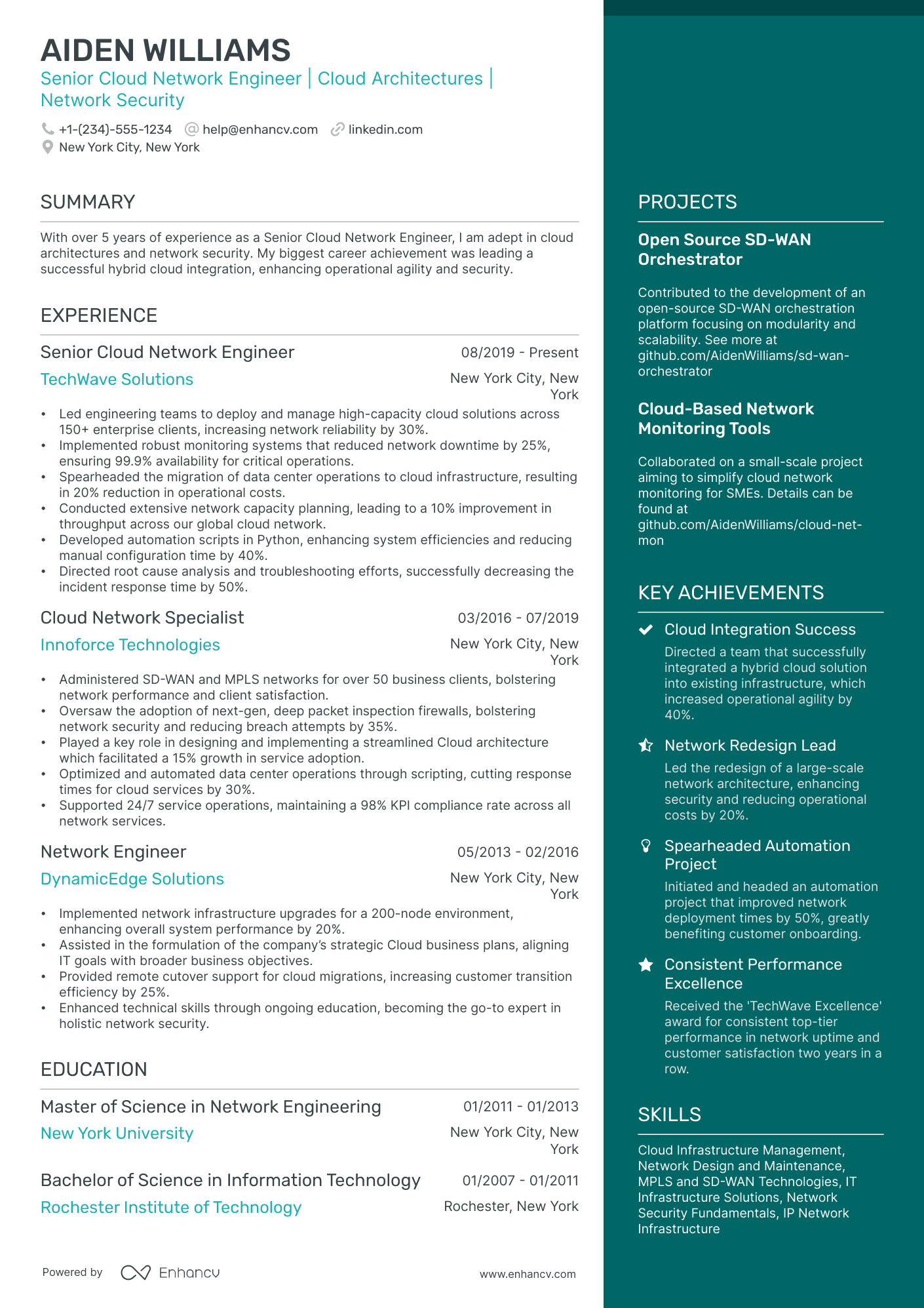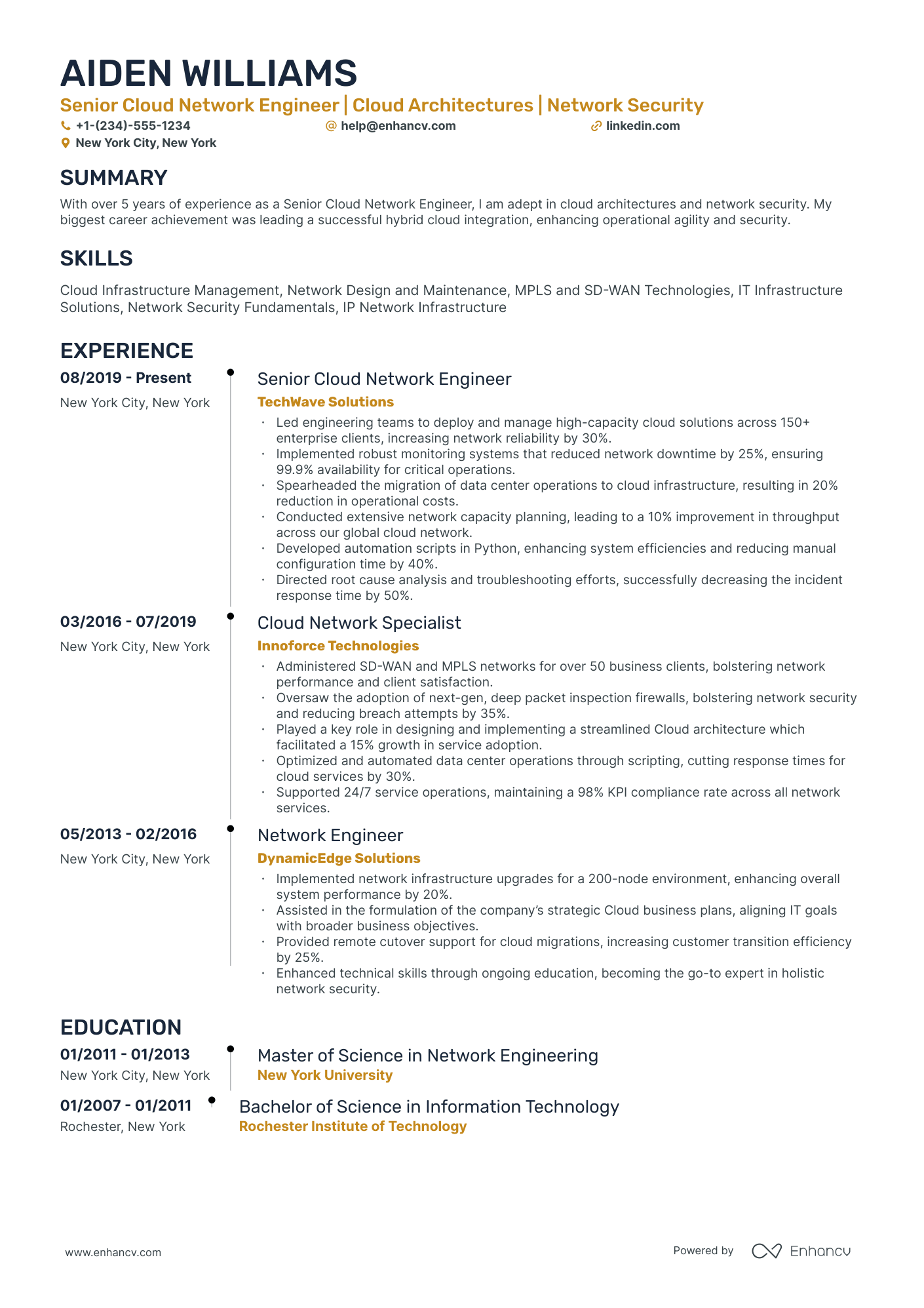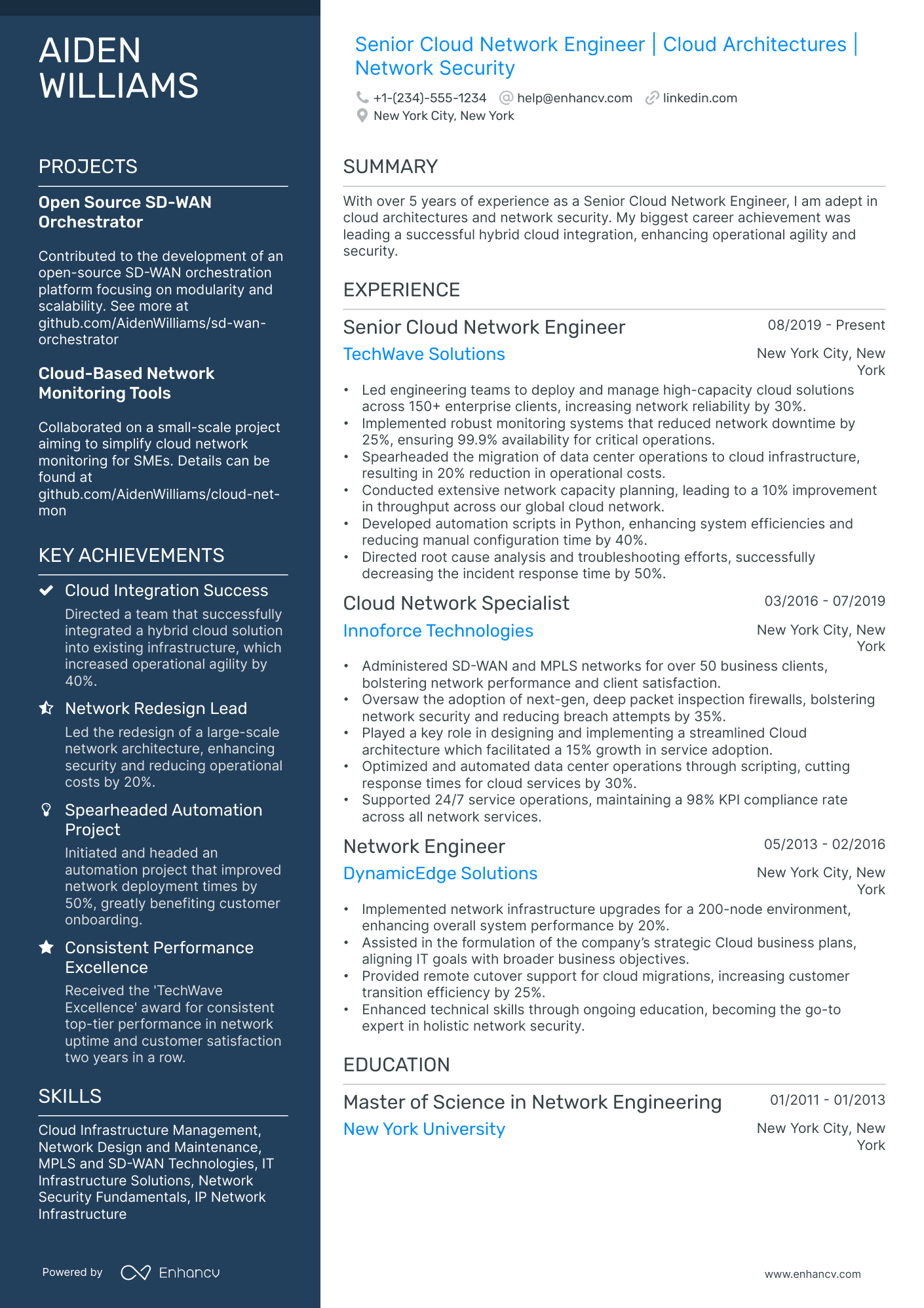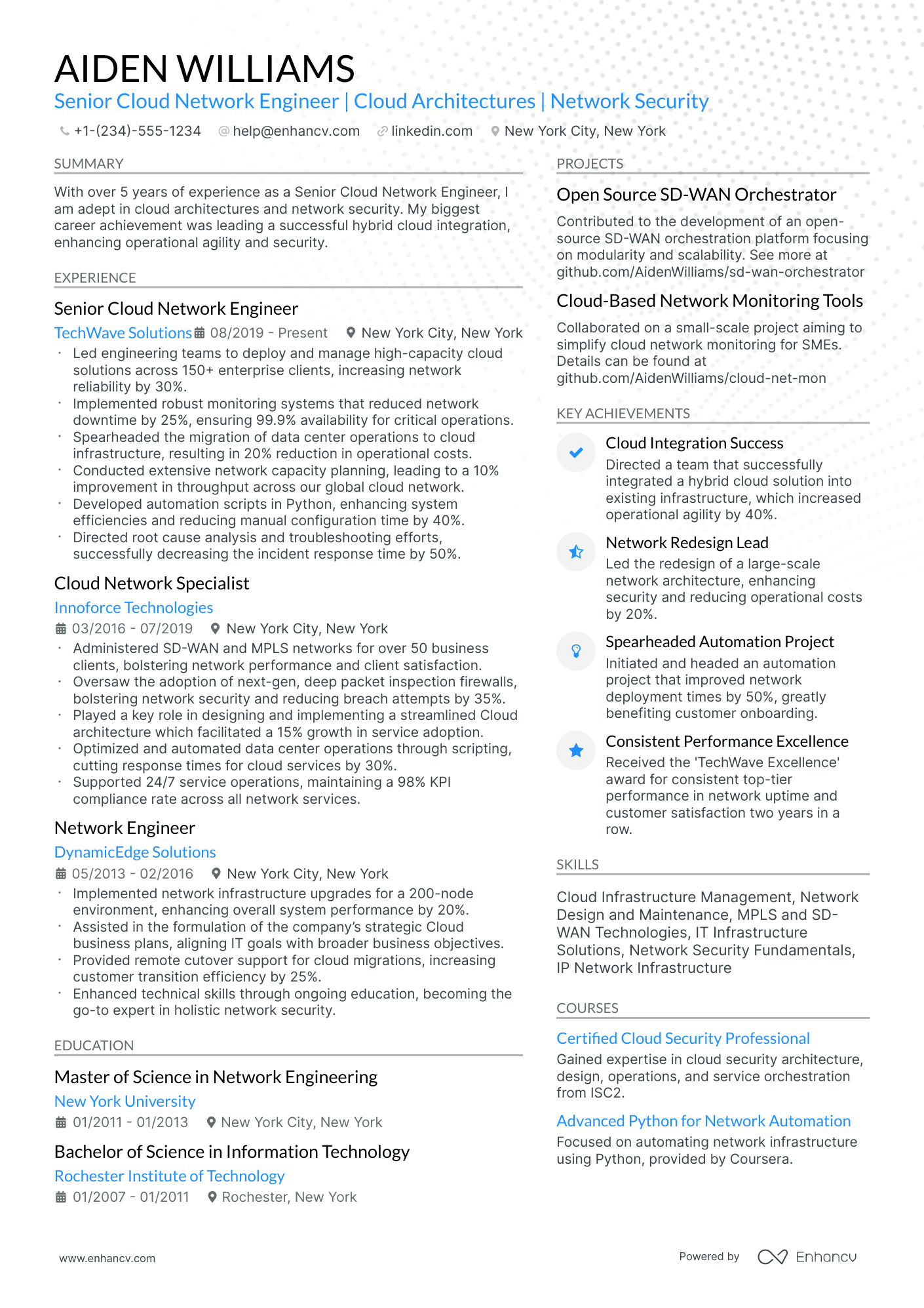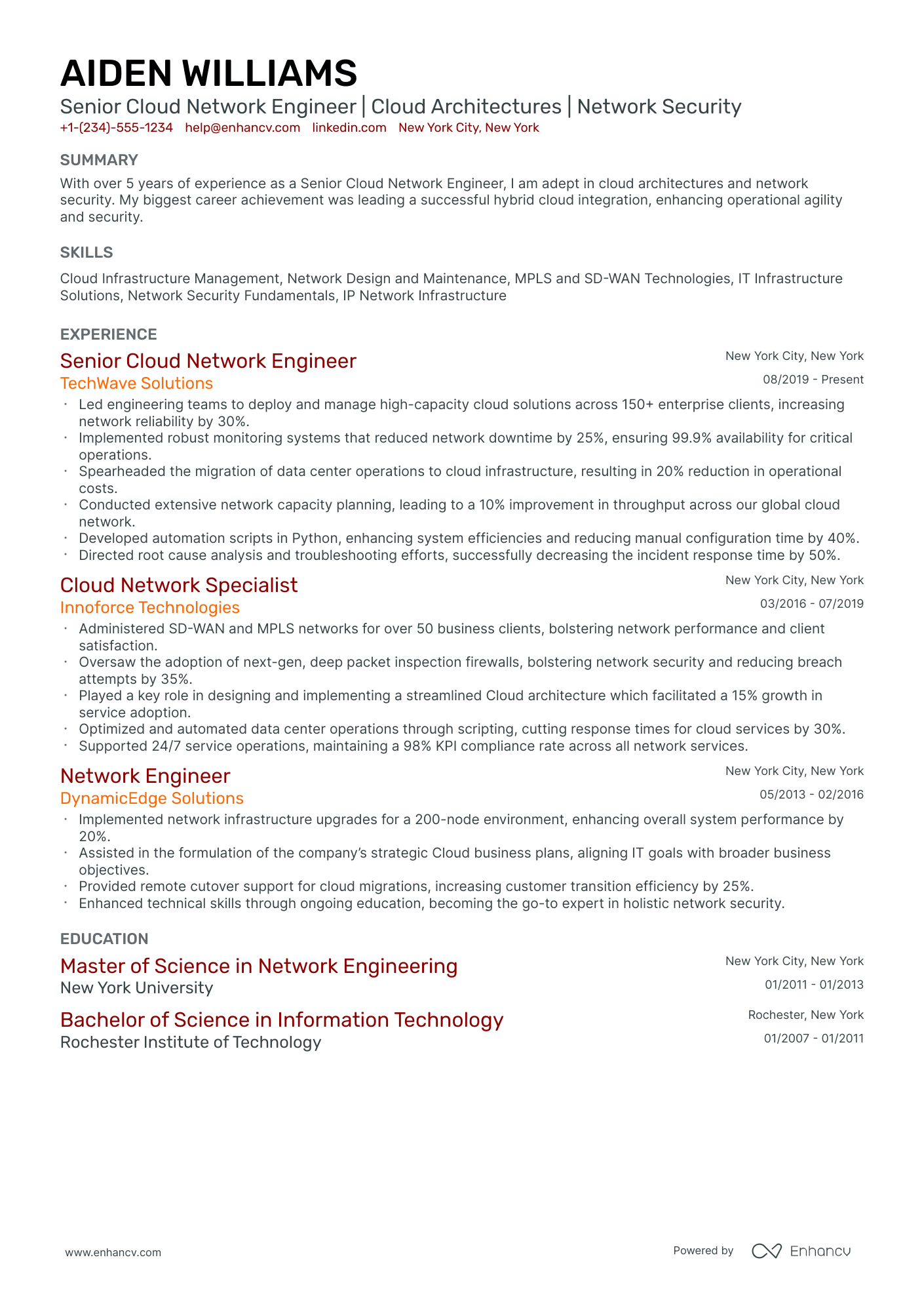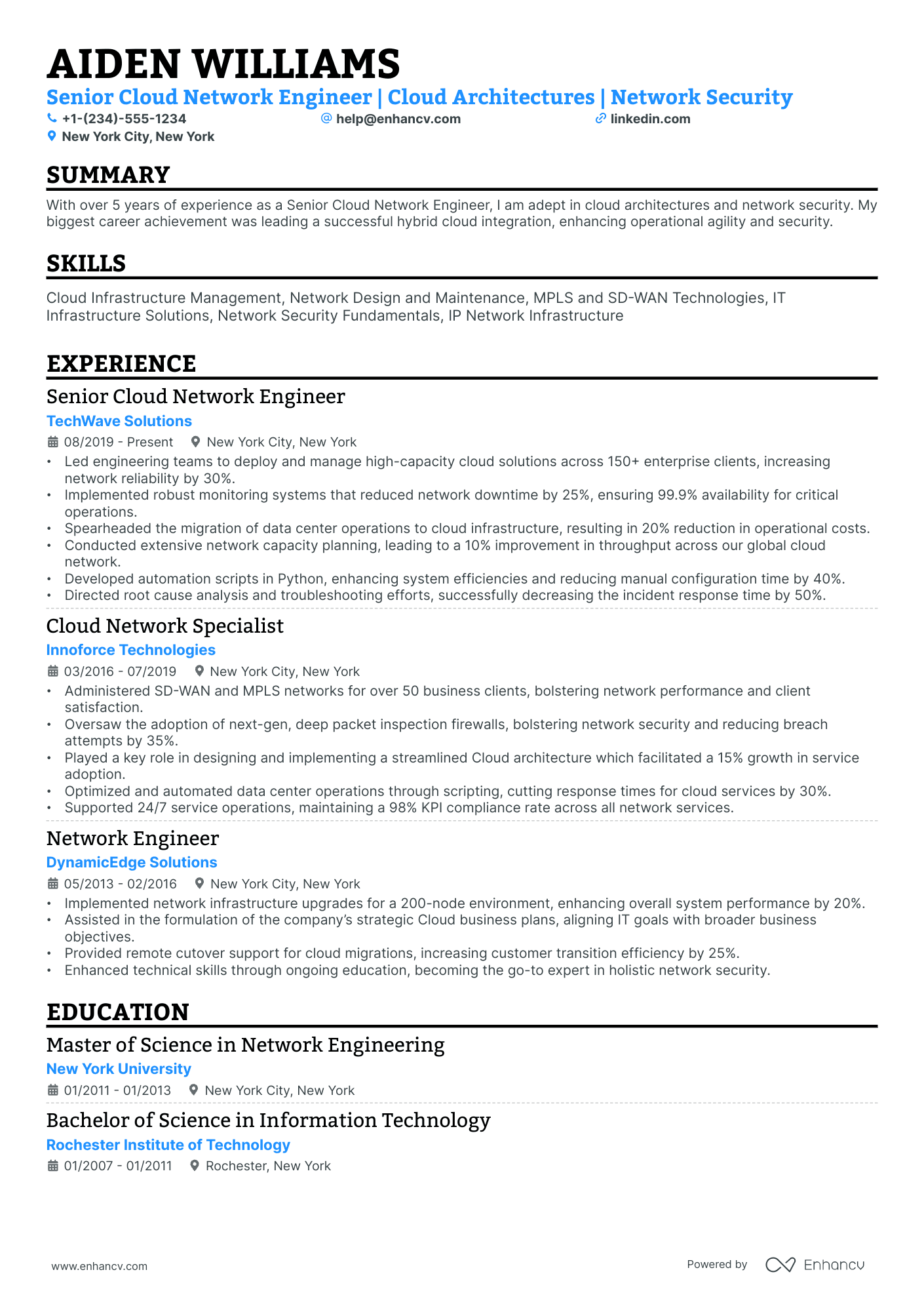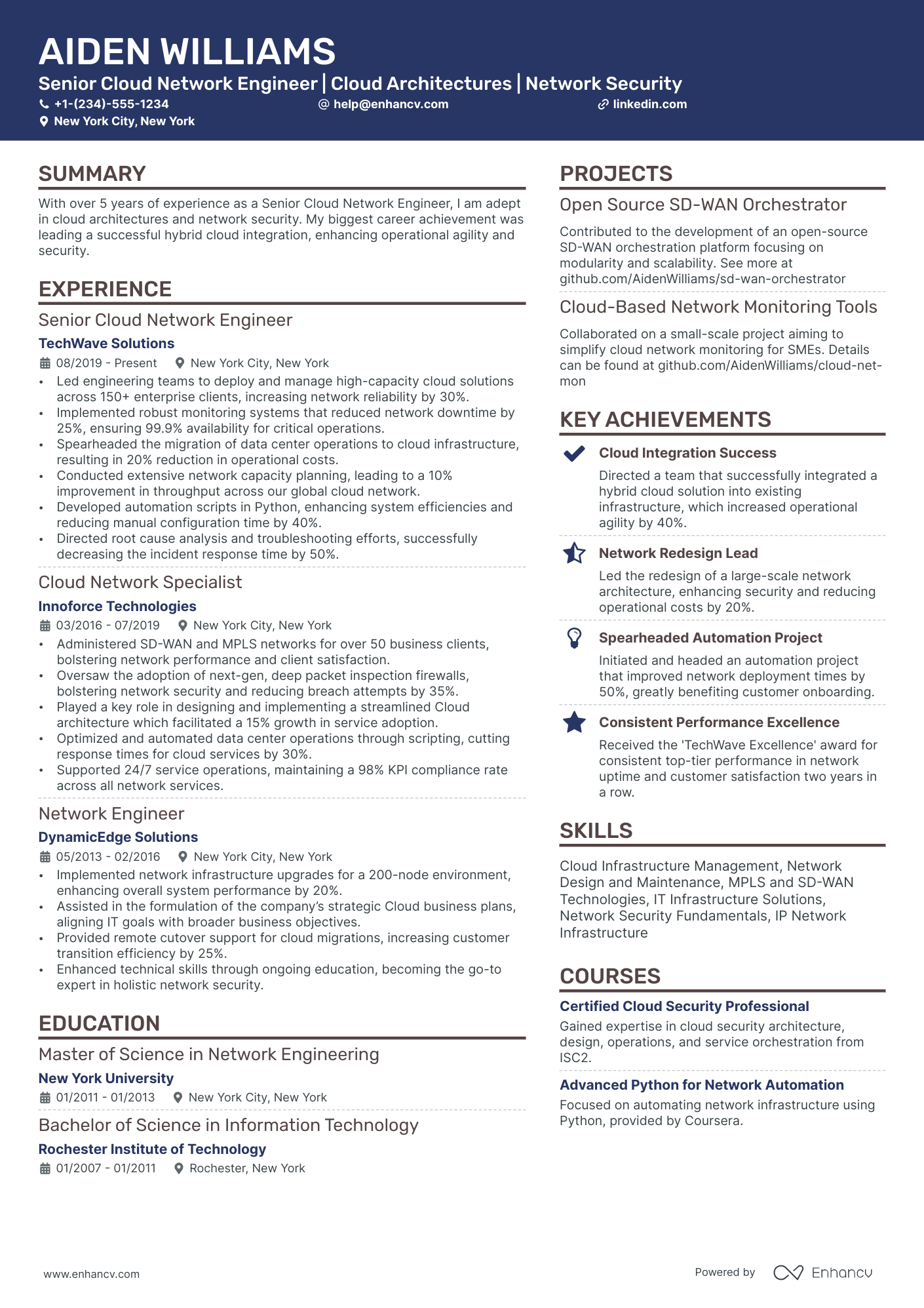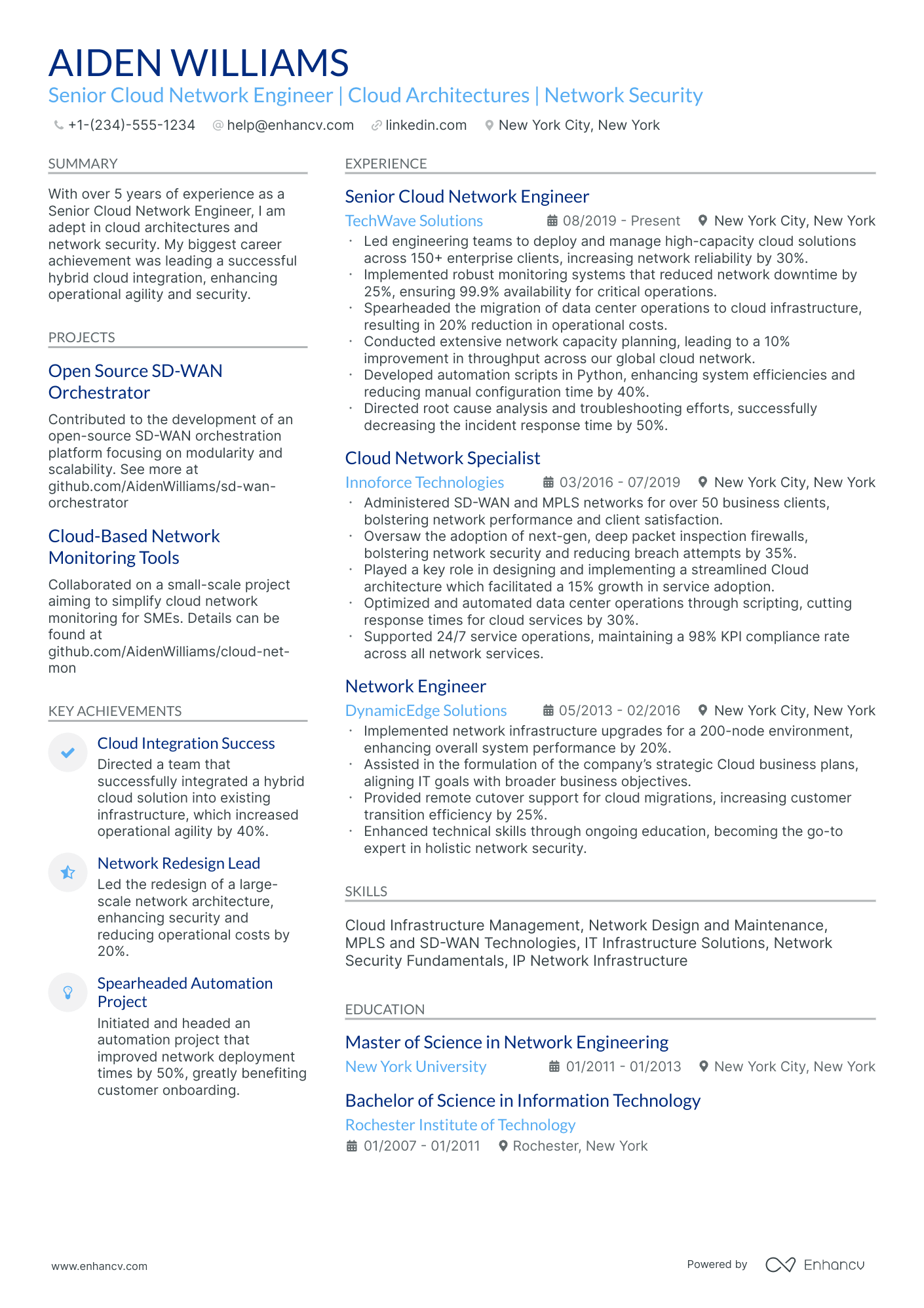As a cloud network engineer, you may struggle with effectively showcasing your wide array of technical skills and project experience in a concise resume format. Our comprehensive guide is tailored to help you highlight your expertise and accomplishments in cloud networking, ensuring your resume stands out to potential employers.
- Which sections do you need to include in your resume to meet recruiters' requirements;
- How to write your cloud network engineer resume experience section - even if you have don't have little to no work experience;
- Real-life professional examples to guide you how to write the most important cloud network engineer resume sections;
- Adding even more sections so your cloud network engineer resume stands out with professionalism and your personality.
We've also selected some of the best (and most relevant) resume guides for the cloud network engineer role you're applying for:
- Game Developer Resume Example
- IT Support Manager Resume Example
- Kubernetes Resume Example
- System And Network Engineer Resume Example
- Computer Engineer Resume Example
- IT Technician Resume Example
- Sophomore Engineering Resume Example
- IT Infrastructure Manager Resume Example
- F5 Network Engineer Resume Example
- Technical Support Manager Resume Example
Is there a correct way to format your cloud network engineer resume?
This is a tricky question. While skimming over your resume, recruiters will be looking at your experience and the message your profile conveys. That's why your resume format needs to be clear and concise, serving to supplement and organize your experience. Professional best practices point that the best cloud network engineer resumes:
- Follow the reverse chronological order, where the most recent experience items are presented first . This is to keep your expertise succinct and to show recruiters your career growth over the years;
- Have a clearly defined header that includes all relevant contact information and a portfolio or a LinkedIn link. In some countries, it is acceptable to include a professional photo , so that your application is more memorable;
- Feature the most important cloud network engineer resume sections towards the top, e.g. summary, skills, and experience. That way, recruiters can immediately find information that is relevant to the role;
- Take up no more than two pages - and two pages are the exception for more experienced professionals. Keep your expertise to the point and use your cloud network engineer resume real estate wisely .
- Selecting modern, yet simple fonts, e.g. Rubik, Lato, etc., would help your application stand out;
- Many candidates stick with the tried-and-tested Arial or Times New Roman, but you'd want your cloud network engineer resume to be a bit more unique;
- The ATS can read all serif and sans-serif fonts, so you should avoid fancy, formal script (or cursive) fonts.
Upload & Check Your Resume
Drop your resume here or choose a file. PDF & DOCX only. Max 2MB file size.
PRO TIP
Highlight any significant extracurricular activities that demonstrate valuable skills or leadership.
Don't forget to include these six sections on your cloud network engineer resume:
- Header and summary for your contact details and to highlight your alignment with the cloud network engineer job you're applying for
- Experience section to get into specific technologies you're apt at using and personal skills to deliver successful results
- Skills section to further highlight how your profile matches the job requirements
- Education section to provide your academic background
- Achievements to mention any career highlights that may be impressive, or that you might have missed so far in other resume sections
What recruiters want to see on your resume:
- Expertise in Cloud Services: Proficiency in major cloud platforms like AWS, Azure, or Google Cloud Platform (GCP).
- Network Security Skills: Knowledge of cloud security protocols, and experience with firewalls, VPNs, data encryption, and security audits.
- Automation and Orchestration: Experience with Infrastructure as Code (IaC) using tools such as Terraform, Ansible, or CloudFormation for the automation of cloud resources.
- Architectural Design: Ability to design and manage scalable, high-availability network architectures within the cloud environment.
- Cloud Service Management: Experience with cloud service models (IaaS, PaaS, SaaS) and cloud management solutions for monitoring, logging, and diagnosing within a cloud infrastructure.
The cloud network engineer resume experience section: a roadmap to your expertise
The resume experience section provides you with an opportunity to tell your professional narrative.
Recruiters, reading between the lines of your resume, use the experience section to better understand your unique skill set, accomplishments, and what unique value you bring about.
Discover five quick steps on how to write your experience section:
- Curate only relevant experience items to the role and include the company, description, and dates; all followed by up to six bullets per experience item;
- Each experience item should feature tangible results of your actions - if you can include a number or percent, this will further highlight your aptitude;
- If you've received any managerial or customer feedback, use short excerpts of it as further social proof of your technical or people skills;
- Make sure you're using the appropriate verb tense when listing your responsibilities;
- Within the description for each role, you could summarize your most noteworthy and relevant achievements.
Now, take note of how a real-world cloud network engineer professional received opportunities at industry leaders with these resume experience sections:
- Designed and deployed a multi-region Amazon Web Services infrastructure that increased system redundancy and cut down response time by 37%.
- Automated network operations using Terraform and Ansible, reducing manual configuration time by over 60% and increasing team productivity.
- Led the migration of 50+ enterprise-level applications to a hybrid cloud environment, resulting in a 30% cost saving on infrastructure expenses.
- Implemented a Cisco-based cloud networking solution that supported a 25% annual growth of the company’s SaaS platform.
- Developed a comprehensive network security strategy that addressed compliance standards, reducing security breaches by 90%.
- Coordinated with cross-functional teams to ensure zero downtime during critical network updates and maintenance.
- Pioneered the use of VMware NSX within the company, centralizing network functions and improving resource provisioning time by 50%.
- Orchestrated a major cloud disaster recovery plan that significantly shortened recovery time objectives for critical services.
- Conducted detailed network traffic analysis to optimize flow and application performance, enhancing user satisfaction rates.
- Established network monitoring using SolarWinds, enabling proactive responses to issues and a 35% decrease in network-related incidents.
- Collaborated on a cloud-based VoIP implementation that supported over 1000 users, improving communication efficiency while cutting costs.
- Provided mentorship and training to junior network engineers, elevating the overall technical skillset of the networking team.
- Spearheaded a project to integrate public cloud services with existing on-premise solutions, delivering a seamless hybrid cloud experience for the user base.
- Achieved a 20% increase in network throughput by optimizing routing protocols and leveraging content delivery networks.
- Instrumental in risk assessments for cloud deployments which led to tailored security policies, mitigating potential vulnerabilities.
- Played a crucial role in the design and execution of a Kubernetes-based microservices architecture, enhancing scalability and reducing go-to-market time for new features by 25%.
- Facilitated network segmentation and access control list (ACL) management, ensuring compliance with GDPR and other privacy regulations.
- Guided the cloud cost-optimization practices that yielded a 20% reduction in annual cloud expenditure without sacrificing performance.
- Formulated a secure connectivity roadmap between different cloud providers, fostering a multi-cloud strategy that improved business continuity plans.
- Exceeded service level agreements (SLAs) by maintaining 99.99% network uptime and promptly resolving any network interruptions.
- Devised custom network automation scripts that saved the company over 200 hours of manual network configuration tasks annually.
- Led the transition to SD-WAN technology, which resulted in a 40% increase in WAN efficiency and reduced operational costs.
- Established a robust Zero Trust Security model for the cloud infrastructure that drastically minimized attack vectors for potential breaches.
- Managed a cross-continental data migration project for high availability and disaster recovery, ensuring data integrity and accessibility.
The following content includes information from "O*NET OnLine" by the U.S. Department of Labor, Employment and Training Administration (USDOL/ETA). Used under the CC BY 4.0 license. The data represents the top responsibilities present on the task lists for cloud network engineer professionals.
Top Responsibilities for Cloud Network Engineer:
- Develop disaster recovery plans.
- Develop or recommend network security measures, such as firewalls, network security audits, or automated security probes.
- Develop and implement solutions for network problems.
- Maintain networks by performing activities such as file addition, deletion, or backup.
- Coordinate network operations, maintenance, repairs, or upgrades.
- Coordinate installation of new equipment.
- Monitor and analyze network performance and reports on data input or output to detect problems, identify inefficient use of computer resources, or perform capacity planning.
- Develop network-related documentation.
- Develop and write procedures for installation, use, or troubleshooting of communications hardware or software.
- Participate in network technology upgrade or expansion projects, including installation of hardware and software and integration testing.
Quantifying impact on your resume
- Include the percentage of network uptime you maintained to demonstrate reliability and operational efficiency.
- Mention the number of cloud migrations successfully executed to showcase project management skills and technical know-how.
- State the amount of data you managed or migrated to the cloud to reflect capability with handling large-scale systems.
- Document cost savings achieved through optimization strategies to underscore fiscal responsibility and impact on budget.
- Highlight the number of security incidents resolved or prevented to emphasize vigilance and proactiveness in cybersecurity.
- List the number of network configurations or deployments managed to show experience and proficiency.
- Quantify user support metrics, such as response times or ticket resolutions, to evidence customer service skills and responsiveness.
- Specify the amount of training sessions or workshops conducted to portray leadership and contribution to team skill enhancement.
Action verbs for your cloud network engineer resume
Four quick steps for candidates with no resume experience
Those with less or no relevant experience could also make a good impression on recruiters by:
- Taking the time to actually understand what matters most to the role and featuring this within key sections of their resume
- Investing resume space into defining what makes them a valuable candidate with transferrable skills and personality
- Using the resume objective to showcase their personal vision for growth within the company
- Heavily featuring their technical alignment with relevant certifications, education, and skills.
Remember that your resume is about aligning your profile to that of the ideal candidate.
The more prominently you can demonstrate how you answer job requirements, the more likely you'd be called in for an interview.
Recommended reads:
PRO TIP
The more trusted the organization you've attained your certificate (or degree) from, the more credible your skill set would be.
The heart and soul of your cloud network engineer resume: hard skills and soft skills
If you read between the lines of the cloud network engineer role you're applying for, you'll discover that all requirements are linked with candidates' hard skills and soft skills.
What do those skills have to do with your application?
Hard or technical skills are the ones that hint at your aptitude with particular technologies. They are easy to quantify via your professional experience or various certifications.
Meanwhile, your soft skills are more difficult to assess as they are personality traits, you've gained thanks to working in different environments/teams/organizations.
Your cloud network engineer resume skills section is the perfect opportunity to shine a light on both types of skills by:
- Dedicating a technical skills section to list up to six technologies you're apt at.
- Focusing a strengths section on your achievements, thanks to using particular people skills or technologies.
- Including a healthy balance of hard and soft skills in the skills section to answer key job requirements.
- Creating a language skills section with your proficiency level - to hint at an abundance of soft skills you've obtained, thanks to your dedication to learning a particular language.
Within the next section of this guide, stay tuned for some of the most trending hard skills and soft skills across the industry.
Top skills for your cloud network engineer resume:
AWS (Amazon Web Services)
Azure Networking
Google Cloud Platform (GCP)
Cisco Networking
Network Security Protocols
VPN Technologies
Load Balancers
Firewalls
SDN (Software-Defined Networking)
Network Monitoring Tools
Problem Solving
Communication
Team Collaboration
Analytical Thinking
Adaptability
Attention to Detail
Time Management
Project Management
Critical Thinking
Customer Service Orientation
Next, you will find information on the top technologies for cloud network engineer professonals from "O*NET OnLine" by the U.S. Department of Labor, Employment and Training Administration (USDOL/ETA). Used under the CC BY 4.0 license.
Top technologies for Cloud Network Engineer’s resume:
- Google Angular
- Spring Framework
- Blink
- Symantec Intruder Alert
- Wireshark
PRO TIP
The more trusted the organization you've attained your certificate (or degree) from, the more credible your skill set would be.
Qualifying your relevant certifications and education on your cloud network engineer resume
In recent times, employers have started to favor more and more candidates who have the "right" skill alignment, instead of the "right" education.
But this doesn't mean that recruiters don't care about your certifications .
Dedicate some space on your resume to list degrees and certificates by:
- Including start and end dates to show your time dedication to the industry
- Adding credibility with the institutions' names
- Prioritizing your latest certificates towards the top, hinting at the fact that you're always staying on top of innovations
- If you decide on providing further information, focus on the actual outcomes of your education: the skills you've obtained
If you happen to have a degree or certificate that is irrelevant to the job, you may leave it out.
Some of the most popular certificates for your resume include:
The top 5 certifications for your cloud network engineer resume:
- Certified Cloud Security Professional (CCSP) - ISC²
- AWS Certified Solutions Architect – Associate (AWS CSAA) - Amazon Web Services
- Cisco Certified Network Associate (CCNA) - Cisco
- Microsoft Certified: Azure Solutions Architect Expert - Microsoft
- Google Certified Professional cloud network engineer - Google Cloud
The content below includes information from "O*NET OnLine" by the U.S. Department of Labor, Employment and Training Administration (USDOL/ETA). Used under the CC BY 4.0 license. The data represents the top associations for cloud network engineer professionals.
Top US associations for a Cloud Network Engineer professional
- CompTIA
- Association for Computing Machinery
- Computing Research Association
- IEEE Computer Society
- Institute for Certification of Computing Professionals
PRO TIP
If the certificate you've obtained is especially vital for the industry or company, include it as part of your name within the resume headline.
Recommended reads:
Writing the cloud network engineer resume summary or objective: achievements, keywords, dreams, and more
Deciding on whether to include a resume summary or resume objective should entirely depend on your career situation.
If you have:
- Plenty of relevant achievements you'd like to bring recruiters' focus to, make use of the resume summary. Ensure each of your achievements is quantified with concrete proof (e.g. % of cases solved).
- Less applicable experience, utilize the resume objective. Within the objective include a few noteworthy, past successes, followed up by your professional dreams.
As a bonus, you could define in either your cloud network engineer resume summary or objective what makes you the perfect candidate for the role.
Think about your unique hard and soft skills that would make your expertise even more important to the job.
These cloud network engineer professionals have completely covered the formula for the ideal resume introduction:
Resume summaries for a cloud network engineer job
- A seasoned cloud network engineer with over 8 years of experience in architecting secure and scalable AWS cloud infrastructures for high-traffic web applications. Highly proficient in automation using Terraform and AWS CloudFormation, adept in network troubleshooting, and contributed to a 30% reduction in operational costs by optimizing cloud resources at TechGenius Inc.
- With a strong 9-year background in system administration and a recent shift to cloud technologies, I bring a unique perspective to engineering resilient cloud networks. Mastered Azure and Google Cloud platforms during my tenure at SecureVault Corp., achieving a 99.9% uptime for our global data centers.
- Distinguished system analyst for 12 years, pivoting into cloud network engineering with fresh certification in AWS Solutions Architect - Associate. Demonstrated quick adaptation by leading a successful cloud migration project at DataOne Analytics, ensuring zero downtime during transition and post-launch performance enhancements.
- Accomplished professional with 6 years of experience in networking, excitedly stepping into the cloud networking field. Earned a reputation for designing robust network infrastructures and successfully executed a large-scale network upgrade project at GlobalCom, increasing throughput by 40%.
- Eager to apply my comprehensive understanding of WAN/LAN and network security fundamentals acquired during my B.S. in Network Engineering to foster innovative cloud solutions. Keen on gaining hands-on experience and contributing to cloud-based projects that leverage the power of automation and advanced cloud technologies.
- As a recent cloud computing enthusiast with a master’s degree from TechForward University, I am committed to applying my academic knowledge of distributed systems and eagerness to learn quickly. I aim to develop cutting-edge cloud networking solutions that enhance scalability and achieve cost-efficiency for emerging startups and established businesses.
Average salary info by state in the US for Cloud Network Engineer professionals
Local salary info for Cloud Network Engineer.” Source: My Next Move, National Center for O*NET Development. Accessed 10/15/2024
| State | Average Salary (in USD) |
|---|---|
| US National Average | $129,840 |
| California (CA) | $144,980 |
| Texas (TX) | $132,400 |
| Florida (FL) | $126,290 |
| New York (NY) | $134,550 |
| Pennsylvania (PA) | $111,650 |
| Illinois (IL) | $131,740 |
| Ohio (OH) | $122,690 |
| Georgia (GA) | $132,370 |
| North Carolina (NC) | $120,660 |
| Michigan (MI) | $105,480 |
Other cloud network engineer resume sections to support your expertise and skills
Recruiters are always on the lookout for that cloud network engineer candidate who brings about even more value to the role.
This can be either via their personality or additional accreditations they have across the industry.
Add to your resume any of the four sections that fit your profile:
- Projects for your most impressive, cutting-edge work;
- Awards or recognitions that matter the most;
- Publications further building up your professional portfolio and accreditations;
- Hobbies and interests to feature the literature you read, how you spend your time outside of work, and other personality traits you deem may help you stand out .
Key takeaways
At the end of our guide, we'd like to remind you to:
- Invest in a simple, modern resume design that is ATS friendly and keeps your experience organized and legible;
- Avoid just listing your responsibilities in your experience section, but rather focus on quantifiable achievements;
- Always select resume sections that are relevant to the role and can answer job requirements. Sometimes your volunteering experience could bring more value than irrelevant work experience;
- Balance your technical background with your personality traits across various sections of your resume to hint at how much time employers would have to invest in training you and if your profile would be a good cultural fit to the organization;
- Include your academic background (in the form of your relevant higher education degrees and certifications) to show recruiters that you have the technical basics of the industry covered.
